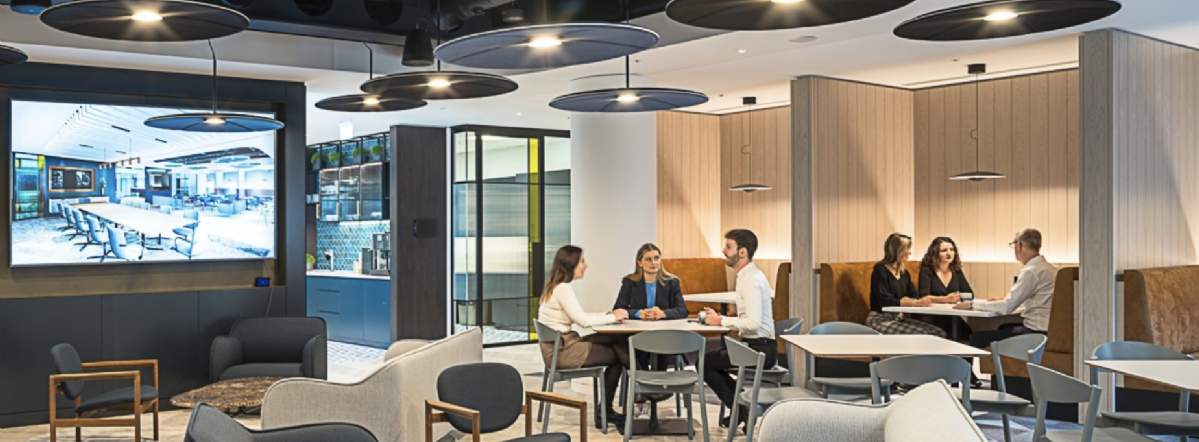Technology companies have long been leaders in adopting innovative office environments and work policies. Ahead of their peers in other industries, tech employees have enjoyed generous amenities, creatively designed workspaces, and ample flexibility in work arrangements.
This trend-setting sector now stands at the confluence of multiple social, economic, and business factors that will impact workplace strategy and policies in the near to medium term. Among these are the sea change to come with AI technology and the question of remote working and its impact on culture and performance.
The fast pace at which the tech industry moves shows no signs of slowing down. Here are a few of the most pressing challenges and opportunities these companies must stay in step with:
Committing to continuous experimentation as new technology develops
The exponential rate at which many forms of technology develop poses challenges for tech businesses. They must maintain the ability to stay nimble as the market moves, scaling operations up or down to compete, or at the more extreme end, transforming operations entirely. The workplace plays an important role in supporting these needs.
Many tech firms view their workspace as a living lab – a place to learn, tinker, create, gather feedback, and iterate. Maintaining organizational capacity to do this effectively means not just hiring the right talent, but also establishing a good balance of both collaborative and heads-down, quiet space as well an appropriate level of flexibility to sustain innovation and invention. Technology, real estate, and HR teams must align to accommodate continuous experimentation and the environments that enable these processes to thrive.
Competing for the most in-demand talent
Tech firms have a consistent need to hire top talent, and workplace strategies will factor into each company’s success with recruitment and retention.
Multiple factors are converging to keep the pressure on companies. Traditional technology firms must play defense as other cutting-edge sectors – such as fintech and biotech – come for their talent. AI is creating new categories of roles and reinventing others – to the tune of an 1,800% increase in U.S. job postings requiring generative AI skills – subsequently pushing firms to compete for the right expertise and knowledge. And with the Federal Trade Commission recently banning non-compete agreements, movement across the industry may accelerate as employees face reduced barriers to leaving their roles.
Employers that offer optimal and engaging workspaces, useful amenities, and rewarding protocols and policies alongside attractive compensation packages will maintain a competitive edge.
Drawing employees into the office while maintaining flexible policies and working environments
Many tech employees have long enjoyed flexibility to work from anywhere. That freedom increased during the pandemic. In the years since, many tech firms are re-examining their work from home policies, especially if business underperformance is a factor or well-equipped offices lie empty.
Some of the top names in technology, such as Zoom, Amazon, and Meta, modified their remote working policies to require some in-office time as the pandemic receded. With employees willing to vote with their feet in the absence of hybrid work arrangements, the onus is on firms to keep flexibility on the agenda while offering compelling environments that accommodate it.
Building culture and team “stickiness”
Tech companies are often composed of a diverse mix of roles and personality types, from primarily extroverted or collaborative functions to more heads-down or introverted tasks. In 2023 and early 2024, as some tech firms initiated layoffs and backfilled selected roles with contract or offshore workers, more positions also became remote. Bringing everyone together to build a cohesive culture and mission, regardless of role or location, continues to challenge tech firms.
Planning space that comfortably accommodates different job functions, encourages teamwork and socializing, and offers equal access for on- or off-site employees is an ideal many tech firms will wish to pursue as they strive to keep their team members connected to larger business initiatives.
Google’s own team-centric approach resulted in the opening of its expansive new headquarters at St. Johns Terminal in New York earlier this year, an example of a work environment wholly focused on helping small teams ideate and collaborate as needed with the flexibility to move around through a variety of settings.
To retrench, or to refocus on growth?
2022 and 2023 were years of efficiency and retrenching for the technology industry. Meta scaled back on the metaverse. Apple scaled back on autonomous driving. Many tech companies cut staff and some issued dividends for the first time to demonstrate interest in profitability to their shareholders. After these measures, will 2024 revive a growth mindset?
Economic conditions, including the direction of consumer spending, inflation, and interest rates, will help determine the industry’s next moves. Capital spending, including investments in the workplace, may be delayed or move forward cautiously in line with each company’s strategy.
Meeting the requirements of local environmental legislation
Urban, coastal markets with high concentrations of tech firms and talent are working to bring their operations in line with local environmental legislation. Local Law 97 in New York, aimed at reducing the carbon emissions of large buildings, and San Francisco’s Climate Action Plan, an overall initiative that outlines city environmental goals, are two such examples. Tech firms along with building landlords need to consider these regulations as they plan their workplaces now and in the coming years.
Workplace policy can play a powerful role in decarbonization efforts. Clear accountability and feedback channels are essential for fostering transparent communication around practices. Encouraging or incentivizing employees to use public transportation, cycling, and carpooling, and greening operations at work (to reduce waste, for instance), are practices that can help build a culture of sustainability. Encouraging employee-led initiatives that cultivate personal agency will boost engagement and can also support a company’s efforts to meet local environmental regulations.
The pursuit of invention and innovation continues
The last couple of decades have proven that the tech industry is not only a pioneer of new inventions, tools, and resources, but also in the work environments it creates to nurture high levels of innovation. Ever-present competition, changing market conditions, and the need to recruit and retain top talent will continue to put pressure on the industry to adapt and evolve. As they navigate these challenges, companies employing the same ingenuity and spirit of experimentation that has always guided their success should find resilience.


.jpg)
.jpg)

.jpg)
.png)
.png)
(1).jpg)
